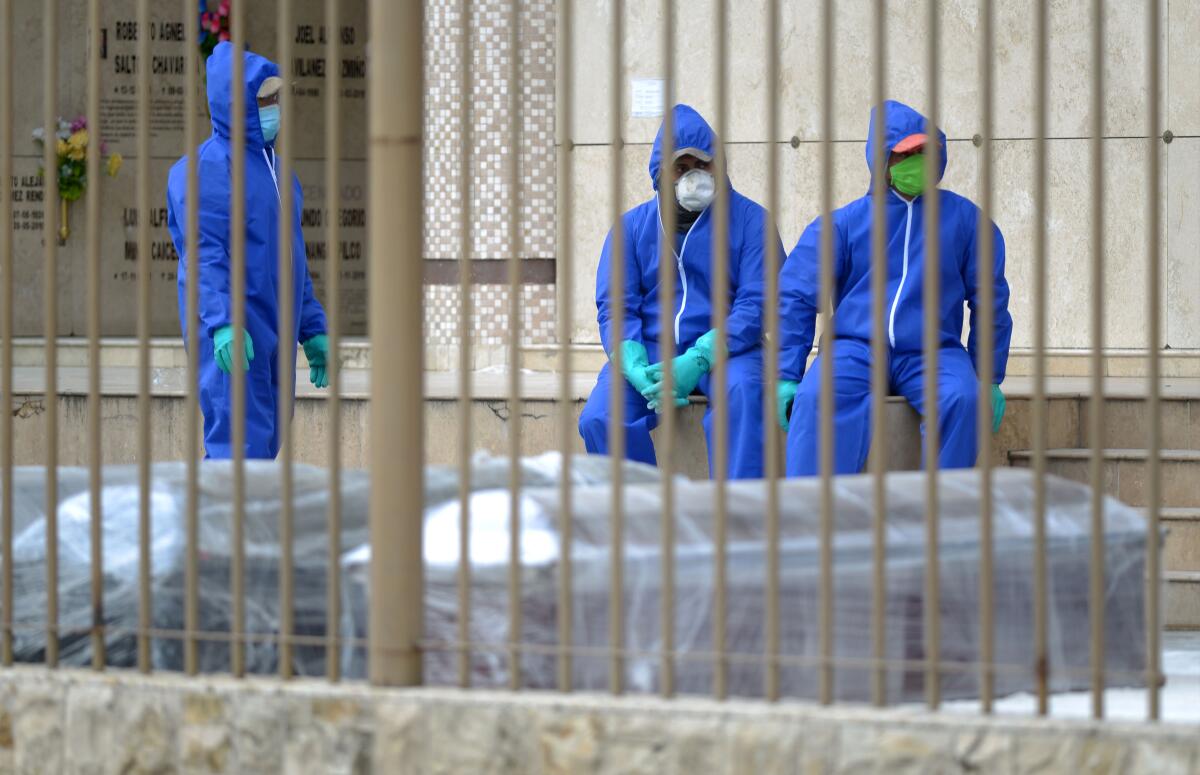No more bodies on the streets. But coronavirus batters Ecuador with disproportionate force

- Share via
QUITO, Ecuador — The grisly scenes of bodies left on the streets of the Ecuadorean city of Guayaquil seemed dystopian even in the era of the coronavirus.
“This peaceful city received a bomb from the air, like Hiroshima,” Guayaquil Mayor Cynthia Viteri told a TV interviewer last week.
The shocking images that went viral in March and April proved a warning about the virus’ capacity to collapse fragile healthcare and mortuary systems, especially in developing nations. But even as such ghoulish scenes have faded, the specter of Guayaquil — which some refer to as the Latin American Wuhan — looms ominously over a region where infections are not expected to peak until coming weeks in many countries as ill-prepared as Ecuador.
In Brazil, critics have warned that the denialist approach of President Jair Bolsonaro — who has dismissed the virus as a “little flu” — could lead to an apocalyptic outcome.
“I fear that if this grows Brazil could see some cases like those horrific, monstrous images we saw in Guayaquil,” former Brazilian President Luiz Inacio Lula da Silva told Britain’s Guardian newspaper.
The prospect of bodies on the streets remains the region’s nightmare scenario.
Claudia López, mayor of Bogota, the capital of neighboring Colombia, recently told a radio interviewer: “I don’t want Bogota to become the next Guayaquil.”
But while corpses no longer litter the streets of Guayaquil, life remains far from normal in the steamy coastal business hub of 2.8 million. Infections and deaths mount daily, and Ecuador remains sealed off and in lockdown. Daily life and the economy are paralyzed throughout the South American nation.
The pandemic has hit Ecuador with disproportionate force.
The country of 17.6 million is the eighth most populous nation in Latin America. Yet it stands second only to Brazil in the number of infections and COVID-19 deaths in Latin America.
Last week, the government announced that confirmed coronavirus cases in Ecuador had reached 22,719. Total deaths linked to the virus, including confirmed and “suspected” cases, stood at 1,636.
Almost 70% of Ecuador’s cases are from coastal Guayas province, which includes Guayaquil. And an estimate from the mayor’s office of the coronavirus death toll during March and April, based on the average number of deaths during that period, shows virus-related fatalities have already exceeded 7,000 in Guayaquil alone.
Brazil — with more than 10 times the number of people — had almost 50,000 cases and close to 4,000 deaths, according to figures from the Pan American Health Organization as of midday Friday.
However, the official statistics from Ecuador are widely viewed as an extreme undercount in a country where testing has been very limited.
“The numbers are way higher than what the government wants to recognize,” said Juan José Illingworth, an Ecuadorean mathematician and newspaper columnist who has examined cemetery data to calculate how many more people are dying than usually would have.
By Illingworth’s analysis, Guayaquil suffered 6,948 likely coronavirus-related deaths between March 21 and April 22, or more than 217 a day.
In normal, non-pandemic circumstances, Illingworth said, 38 people would be expected to die each day in Guayaquil.
The peak of the crisis, Illingworth said, was April 6, when likely virus-related deaths soared to 460, further taxing already overwhelmed hospitals, morgues and funeral homes.
The city, he surmised, has “sustained the equivalent of 10 earthquakes.”
An earthquake in 2016 killed about 670 people throughout Ecuador.
Official data from Ecuador’s civil registry department — which maintains records of births and deaths nationwide — confirm that the Guayaquil area has experienced an extreme surge in mortality. In Guayas province, 13,162 deaths were recorded between March 1 and April 22, 2020, the registry shows. That compares with 3,771 deaths for all of March and April 2019, and 3,459 deaths during the same period in 2018.
Tropical Guayaquil’s extreme heat and humidity — the city sits at sea level about 152 miles south of the equator — clearly did not foil the contagion. That would seem to undermine assertions by President Trump and others that the onset of warmer weather in the Northern Hemisphere may slow the rate of infections.
A combination of factors likely contributed to the immense toll in Guayaquil, a bustling port city filled with open markets and a vibrant street life.
Traditional holidays in the sweltering month of February sent many people outdoors for sports matches, cultural performances, weddings and other public events. Many probably spread the contagion without knowing they were infected.
“Guayaquil became a bomb for distributing the virus,” said Dr. Marcelo Aguilar, an Ecuadorean epidemiologist.
Meanwhile, many vacationers opted to fly to or from Spain and Italy, both home to large numbers of Ecuadorean immigrants. Those two Mediterranean nations were early coronavirus hot spots. Some travelers brought the virus back to Guayaquil from Europe.
Ecuador’s first coronavirus fatality was reported in Guayaquil on March 13. The victim: a 71-year-old woman who had recently returned from Spain.
Residents of Guayaquil, experts say, were also slow to heed initial lockdown orders issued from the capital, Quito. Street sales in the informal economy are a mainstay in a metropolis featuring profound economic disparities — affluent and middle-class residents, some residing in exclusive gated communities, coexisting with multitudes of the impoverished, crammed into homes and apartments where social distancing is a challenge.
For many, going outdoors provides the only respite from the unrelenting heat.
“Guayaquil is a very heavily populated city, with huge movements of residents,” noted Aguilar. “But it is also very unequal.”
On March 24, as the numbers of deaths and infections soared, the government imposed a nationwide 2 p.m. to 5 a.m. curfew — except for health workers and others deemed essential — and tasked the military with enforcing it. Scores of violators were detained. Hotel rooms in Guayaquil were set aside for the growing ranks of ill.
Among those infected were officials including Mayor Viteri and her husband. Both were quarantined and recovered. The mayor, 54, a former presidential candidate, sent out frantic Twitter messages during the crisis.
Fearing contagion imported from hard-hit Europe, the mayor dispatched municipal vehicles to the airport runway to block a pair of international flights, from Iberia and KLM, destined to land in Guayaquil. The planes had been sent to pick up European nationals stranded in Guayaquil amid the quarantine. Crews were planning to stay in the city until the flights took off again, the mayor said.
“Don’t bring people from Europe to Guayaquil,” the mayor warned in a video message. “I assume the responsibility to protect my citizens.”
As caseloads ballooned and the sanitation and mortuary systems collapsed, scattered numbers of bodies began to appear on the streets in March. Some were the remains of indigents. Others were left by relatives or others who faced an agonizing situation: Corpses were decomposing in homes in the 90-degree daytime weather, and besieged authorities were not responding.
One family told an Ecuadorean newspaper that the corpse of a grandfather remained at home for four days until officials finally arrived to take it away. A video of a woman pleading with authorities to collect the remains of her husband from the family home went viral.
“I don’t know how long I have to wait,” the woman said.
The images of bodies left on sidewalks and corners, at doorways and porticos, shocked the world. Largely unseen were the many more corpses piling up in hospitals, morgues and homes.
Sanitation teams were eventually dispatched to collect hundreds of cadavers from streets, hospitals and residences. Many bodies ended up in donated cardboard coffins for interment in newly minted cemeteries.
Today, the macabre scenes have been largely replaced by images of health staffers in hazmat suits and lab smocks fumigating streets and handing out disinfectant kits, medicines, food and other basics to slum dwellers and others in Guayaquil. The stream of daily fatalities has decreased from the early April peak, say authorities, who express hope that the tide has turned in a battle that once seemed lost on the streets.
Guayas province reported 56 deaths Wednesday, according to civil registry data, down from a peak of more than 600 deaths on days in early April.
“Finally, we turned around and stopped running from the virus and began to pursue the enemy,” Viteri told the TV interviewer last week. “Like in Sparta.”
Times staff writer McDonnell reported from Mexico City and special correspondent Jaramillo Viteri from Quito. Special correspondent Cecilia Sánchez in Mexico City contributed to this report.
More to Read
Sign up for Essential California
The most important California stories and recommendations in your inbox every morning.
You may occasionally receive promotional content from the Los Angeles Times.













